GenCon 2011 Report
 Since I’m nearly local, I make an annual journey down to Indianapolis once a year to visit GenCon, one of the largest gaming conventions in the U.S., and one of the most important for board game and role playing game fans. This year, my family conveniently scheduled a reunion for the same weekend but I still managed to attend for the first day of the convention. What follows is a small excerpt of some of the more interesting games I came across. For details on some more obscure titles, visit my photo-centric overview over at the blog Opinionated Gamers.
Since I’m nearly local, I make an annual journey down to Indianapolis once a year to visit GenCon, one of the largest gaming conventions in the U.S., and one of the most important for board game and role playing game fans. This year, my family conveniently scheduled a reunion for the same weekend but I still managed to attend for the first day of the convention. What follows is a small excerpt of some of the more interesting games I came across. For details on some more obscure titles, visit my photo-centric overview over at the blog Opinionated Gamers.
Franchise Games
One thing that has become more and more popular in boardgames (frankly, everywhere) is to tie in big franchise names and settings. Boardgames are no exception and one can find boardgames based on popular science fiction, fantasy, and even horror settings.) For video gamers, some may be interested in the new release of Gears of War by Fantasy Flight Games.
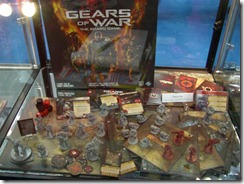 Gears of War is a very popular and very non-kid friendly video game on consoles. It is also an upcoming boardgame from Fantasy Flight. It is a cooperative dungeon crawl (1-4 players) in the Gears of War setting, think of it as Doom or Descent but without one player opposing the others. Players use a variety of weapons and characters to try to beat the game which is run by an AI deck. While there is no player elimination, the game is rumored to be quite brutal.
Gears of War is a very popular and very non-kid friendly video game on consoles. It is also an upcoming boardgame from Fantasy Flight. It is a cooperative dungeon crawl (1-4 players) in the Gears of War setting, think of it as Doom or Descent but without one player opposing the others. Players use a variety of weapons and characters to try to beat the game which is run by an AI deck. While there is no player elimination, the game is rumored to be quite brutal.
Fantasy Flight has also acquired a license for Star Wars games, and has two prominent ones in development: Star Wars: The Card Game, and another game based around Star Wars starship miniatures. In Star Wars: The Card Game, players can use one of four prebuilt faction decks (Operatives, Military, Tech/Droids/ or Rogue) and team up with a friend to try to defeat a set of mission cards (typically 3 or 4 missions). Players place ships on the board that serve as resources (tap them to play other cards) and also protect one’s home base (untapped ships fight off invading ships from the Empire…) Players place operative cards on the table and then use their skills to try to complete the topmost mission card. If the mission is not completed in the requisite amount of time, the mission ends and the next card begins. However, “bad things happen” at the start of the next mission if players failed on the previous one. To win, simply complete the final mission card. However, players can lose in several ways, such as failing the final mission or losing both their home bases (a player is eliminated if they lose their home base.) (*My understanding is that the game will be released and supported by frequent sets of non-randomized cards containing new player cards as well as new missions, etc…)
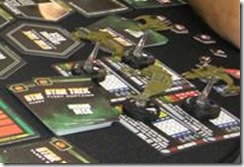 Meanwhile, Wizkids games has a Star Trek license and isn’t afraid to use it. They also have a starship miniatures game, Star Trek: Fleet Captains. In Star Trek: Fleet Captains, where two players go head to head with little Trek space ship figurines complete with standard WizKids “click” base dials showing different levels of damage (white, yellow, and red alert) and thus modifying ships’ stats as they take damage. The game is one of exploring a tile hex grid to control locations by building outposts, colonies, and starbases in order to gain victory points. Of course, just blowing the other guys’ ships out of the water also grants victory points. The game seems moderately complex, close to the border of miniatures rules with things like cloaking, sensors, weapon systems, and paying energy for things. Game setup can vary, but a standard setup is a 5 x 5 grid of hexes played to a cap of 10 victory points. The VP value also determines the max size of a player’s fleet at any time, so players can replace lost ships but don’t generally launch new ones unless they’ve just lost one. At a $100 price point, the game isn’t going to be for everyone, but people who like the Trek license, spaceships, or tactical combat games will need to give it a look-see.
Meanwhile, Wizkids games has a Star Trek license and isn’t afraid to use it. They also have a starship miniatures game, Star Trek: Fleet Captains. In Star Trek: Fleet Captains, where two players go head to head with little Trek space ship figurines complete with standard WizKids “click” base dials showing different levels of damage (white, yellow, and red alert) and thus modifying ships’ stats as they take damage. The game is one of exploring a tile hex grid to control locations by building outposts, colonies, and starbases in order to gain victory points. Of course, just blowing the other guys’ ships out of the water also grants victory points. The game seems moderately complex, close to the border of miniatures rules with things like cloaking, sensors, weapon systems, and paying energy for things. Game setup can vary, but a standard setup is a 5 x 5 grid of hexes played to a cap of 10 victory points. The VP value also determines the max size of a player’s fleet at any time, so players can replace lost ships but don’t generally launch new ones unless they’ve just lost one. At a $100 price point, the game isn’t going to be for everyone, but people who like the Trek license, spaceships, or tactical combat games will need to give it a look-see.
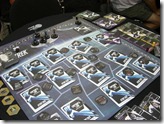 Personally, I’m more interested in Wizkids’ other Trek game, Star Trek: Expeditions. It is a cooperative Star Trek game where players take on the role of the main officers attempting to placate the various powers and issues going on at a given planet before disruptive aliens arrive and all heck breaks loose. The game is one of management of many limited resources, of which time may be the trickiest one of all. I didn’t get a deep look at it yet but hope to run a full review in a few weeks. Technically, it came out early this year, but I’ve not yet had a chance to look it over.
Personally, I’m more interested in Wizkids’ other Trek game, Star Trek: Expeditions. It is a cooperative Star Trek game where players take on the role of the main officers attempting to placate the various powers and issues going on at a given planet before disruptive aliens arrive and all heck breaks loose. The game is one of management of many limited resources, of which time may be the trickiest one of all. I didn’t get a deep look at it yet but hope to run a full review in a few weeks. Technically, it came out early this year, but I’ve not yet had a chance to look it over.
Even traditional Euro-game publisher, Z-Man Games is getting into the franchise business with two titles: Guards Guards (set in Pratchett’s Discworld fantasy universe) and The Walking Dead (set in the world of Kirkmann’s graphic novel of the same name.)
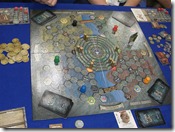 Guards, Guards (an excellent book, by the way) is now also a boardgame for 2 to 6 players. Taking on the role of one of four guild factions, each player is attempting to capture five of the eight escaped major spells from the Unseen University library. Players use volunteer cards (of three types), items, scrolls, and money to try to either capture a spell or simply mess with the other players. Dragons also can appear in the game and can be quite troublesome for those unprepared (you can even call them if you wish.) While I’m sure the game won’t be quite as good as reading a Pratchett novel, just being set in the right universe is enough to make me highly interested in this game when it comes out.
Guards, Guards (an excellent book, by the way) is now also a boardgame for 2 to 6 players. Taking on the role of one of four guild factions, each player is attempting to capture five of the eight escaped major spells from the Unseen University library. Players use volunteer cards (of three types), items, scrolls, and money to try to either capture a spell or simply mess with the other players. Dragons also can appear in the game and can be quite troublesome for those unprepared (you can even call them if you wish.) While I’m sure the game won’t be quite as good as reading a Pratchett novel, just being set in the right universe is enough to make me highly interested in this game when it comes out.
As for The Walking Dead, I don’t read too many graphic novels, but I’m familiar with much of Kirkmann’s work. Kirkmann’s The Walking Dead is a game for 1 to 6 players set near a zombie-infested area surrounding Atlanta. Players need to defeat various challenges to survive and may even cooperate with each other as they do so, but beware of leaning too much on others as they can leave you high and dry at any time. My understanding is that the game has many tie-ins to the written story, but tries to keep things different enough so that players who haven’t read the book will not be at a disadvantage.
Finally, we have the 800-lb gorilla at the show, Wizards of the Coast. They’re large enough that I’m considering their big push of Neverwinter themed material as franchising themselves…
This fall kicks off the season of Neverwinter at Wizards. All sorts of things are in the works including a new hardcover campaign book (for players and DMs) out later this month, a new season of Encounters (a drop-in-and-play session held at game stores each Wednesday evening where newcomers can try out Dungeons and Dragons for an hour) based around Neverwinter, new fiction books about Neverwinter, the upcoming Atari MMORPG called Neverwinter on the PC later this year, and even a Neverwinter themed D&D type game appearing up on Facebook in the near future. All this Neverwinter is fine and good, but what about boardgames?
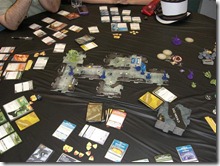 Well, the new Dungeons and Dragons Boardgame entitled: The Legend of Drizzt Boardgame was on hand and playable up in the main D&D ballroom area. Releasing October 18th, it features new monsters and scenarios (compatible with Ashardalon and Ravenloft) as well as new heroes. Rather than generic heroes this time out, players play as well known characters from the Drizzt series of stories including Wulfgar, Regis, Bruneor, and even the battlerager, Athrogate. In addition, boardgaming was a topic of conversation at the product seminar held later that week. It was announced that the Dungeon of Dread boardgame is no longer scheduled to be released as it just wasn’t at a level of quality they were hoping for. However, a new game was announced – Lords of Waterdeep – which is a Euro-style game set in the famous city of Waterdeep. Players recruit adventures, put plans into motion, and backstab each other in order to win the game. One final gaming-related note, D&D Miniatures will be coming back again. They’ll be sold in non-random packs and will also be useable in a new tactical game (that _doesn’t_ use dice.) The minis will be activated/used via a set of cards so there will be some randomness to the game but the emphasis will be on tactics.
Well, the new Dungeons and Dragons Boardgame entitled: The Legend of Drizzt Boardgame was on hand and playable up in the main D&D ballroom area. Releasing October 18th, it features new monsters and scenarios (compatible with Ashardalon and Ravenloft) as well as new heroes. Rather than generic heroes this time out, players play as well known characters from the Drizzt series of stories including Wulfgar, Regis, Bruneor, and even the battlerager, Athrogate. In addition, boardgaming was a topic of conversation at the product seminar held later that week. It was announced that the Dungeon of Dread boardgame is no longer scheduled to be released as it just wasn’t at a level of quality they were hoping for. However, a new game was announced – Lords of Waterdeep – which is a Euro-style game set in the famous city of Waterdeep. Players recruit adventures, put plans into motion, and backstab each other in order to win the game. One final gaming-related note, D&D Miniatures will be coming back again. They’ll be sold in non-random packs and will also be useable in a new tactical game (that _doesn’t_ use dice.) The minis will be activated/used via a set of cards so there will be some randomness to the game but the emphasis will be on tactics.
Deckbuilding Games
One of the newest genres of board and card games came out just a few years ago in a game titled Dominion. In Dominion, players start with a small personal deck of cards which they use to obtain new cards from a selection in the middle of the table. These new cards are added into the players’ decks and thus get used when it becomes time to shuffle again. Thus, players “build up” a deck of cards throughout the game, getting more powerful by the end of the game. In Dominion, players attempt to buy the more expensive Victory cards which grant points at the end of the game, but fail to provide any use during the game. Thus, players need to initially focus on making their decks better, then try to purchase many Victory cards before the game ends. Dominion won many awards and has had many expansions (the newest one, Cornucopia came out this summer and I recoomend it.) Meanwhile, many other designers have taken the basic concepts and applied them to new games wit a bit of variation. Two established deckbuilding games, Nightfall and Thunderstone, come from Alderac Entertainment Games and they had their newest expansions on hand. Thunderstone combines deckbuilding with a sort of dungeon crawl where players either shop for cards in a village or use their “adventurer” and item cards to defeat monsters in a dungeon for points. Nightfall is a horror themed deckbuilding game (werewolves, zombies, and vampires) that is designed for multiplayer play and has much more interaction between players than other games in the genre. Since it is easy to gang up on the leader, it has a strong diplomatic component, but is a hit around her among the high school students. Yet another established deckbuilding game is Ascension by Gary Games. Rather than standard sets of cards from which to purchase, Ascension uses a single deck and has a rotating tableau throughout the game. Ascension has done well (check it out on the iPad) and now has an expansion available: Return of the Fallen.
As for the new deckbuilding games, they were out in force. Fantasy Flight Games (FFG) had several on display including Blood Bowl: Team Manager.
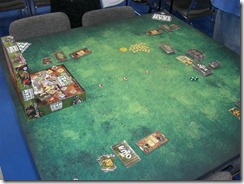 Released at GenCon, Blood Bowl: Team Manager is probably the highest profile deckbuilding game FFG has at the moment. Based in the fantasy-world football setting of the Blood Bowl miniatures game, Team Manager is a bit like the card game BattleLine where players take turns placing cards on two sides of trophy cards, hoping to have the highest value on each trophy when the round ends. However, in Team Manager players use decks constructed throughout the game. Each round, one “match” card per player is placed in the center of the table. Players take turns placing their cards onto one side of each match, although only one player can be on each of the two sides. Just being present at a match wins players rewards, while greater rewards go to the player with the highest value(s) present when all placement ends. Rewards include things like the ability to recruit new players (from a global or private themed deck), new team abilities (again from a common or private pool), or recruiting fans which serve as the games’ victory points. Of course, this is Blood Bowl football so many of the cards placed have additional effects that mess with other cards present (including some cards that “cheat” and hope they don’t get caught). After several rounds of play, a larger, more important final round occurs where the largest dole out of fans occurs. However, winning the final match isn’t a guaranteed win. The game has six different factions available and should be in stores very soon.
Released at GenCon, Blood Bowl: Team Manager is probably the highest profile deckbuilding game FFG has at the moment. Based in the fantasy-world football setting of the Blood Bowl miniatures game, Team Manager is a bit like the card game BattleLine where players take turns placing cards on two sides of trophy cards, hoping to have the highest value on each trophy when the round ends. However, in Team Manager players use decks constructed throughout the game. Each round, one “match” card per player is placed in the center of the table. Players take turns placing their cards onto one side of each match, although only one player can be on each of the two sides. Just being present at a match wins players rewards, while greater rewards go to the player with the highest value(s) present when all placement ends. Rewards include things like the ability to recruit new players (from a global or private themed deck), new team abilities (again from a common or private pool), or recruiting fans which serve as the games’ victory points. Of course, this is Blood Bowl football so many of the cards placed have additional effects that mess with other cards present (including some cards that “cheat” and hope they don’t get caught). After several rounds of play, a larger, more important final round occurs where the largest dole out of fans occurs. However, winning the final match isn’t a guaranteed win. The game has six different factions available and should be in stores very soon.
Another FFG game that caught my eye was Rune Age.  Rune Age is a deckbuilding game with different winning conditions each time you play. As in some deckbuilding games, players have a selection of private (4 or 5) and public (6 or so) cards from which to “buy”, but rather than a standard end game Rune Age is played with a specific scenario each time. There are four scenarios in the base game, each with their own event deck (which is “stacked” into several stages). A new card is drawn each round, giving each scenario much more of an overarching theme. The wider theme, of course, being set in the FFG Runebound setting. The scenarios vary quite a bit, with one of the four actually a cooperative game. Of course, if that’s not your cup of tea, I’m assured there are even rules for player vs player “combat” in the game. While I haven’t seen the game in detail, it looks to be a strong enough departure from most deckbuilding games to make me very interested in giving it a go.
Rune Age is a deckbuilding game with different winning conditions each time you play. As in some deckbuilding games, players have a selection of private (4 or 5) and public (6 or so) cards from which to “buy”, but rather than a standard end game Rune Age is played with a specific scenario each time. There are four scenarios in the base game, each with their own event deck (which is “stacked” into several stages). A new card is drawn each round, giving each scenario much more of an overarching theme. The wider theme, of course, being set in the FFG Runebound setting. The scenarios vary quite a bit, with one of the four actually a cooperative game. Of course, if that’s not your cup of tea, I’m assured there are even rules for player vs player “combat” in the game. While I haven’t seen the game in detail, it looks to be a strong enough departure from most deckbuilding games to make me very interested in giving it a go.
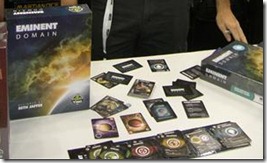 I was excited to drop by Tasty Minstrel Games, since I had not yet met the folks there, and I had recently reviewed Seth Jaffee’s iPad game, Brain Freeze. He has a new deckbuilding game out, Eminent Domain. In it players use role cards in their decks to execute actions. When you execute a role, you gain more cards of that type. Since actions can become more powerful if you play similar actions from your hand, specializing in particular actions will eventually make you better at it. It looks to have some good possibilities and the production values seemed pretty darn good for a new, independent company.
I was excited to drop by Tasty Minstrel Games, since I had not yet met the folks there, and I had recently reviewed Seth Jaffee’s iPad game, Brain Freeze. He has a new deckbuilding game out, Eminent Domain. In it players use role cards in their decks to execute actions. When you execute a role, you gain more cards of that type. Since actions can become more powerful if you play similar actions from your hand, specializing in particular actions will eventually make you better at it. It looks to have some good possibilities and the production values seemed pretty darn good for a new, independent company.
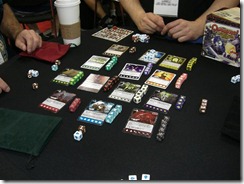 The final “deckbuilding” game to mention is the most unique. Rather than using cards, players build up a pile of dice. Quarriors is a mix of dice and deck construction to make a dice (pool) construction game. Players use (roll) their basic dice to gain resources which can be used to buy more powerful dice. Those dice will eventually be rolled and can become monsters which attack other players dice. If your dice survive until the start of your next turn, you earn points. There are 130 dice contained the game’s very creatively packaged collector’s tin. There are 15 types of “advanced” dice and each of those have different powers in the game, depending on the card drawn for that die type at the beginning of the game. Only 10 advanced die types are used per game, so that leaves plenty of variability in the basic game tin to explore. Upon opening, I appreciated the handy dice bags and the many colorful dice (I need to keep them away from my dice loving 2 year old). They are slightly smaller than I expected, but it makes sense (both from a price point as well as “fit in the bag” point of view.)
The final “deckbuilding” game to mention is the most unique. Rather than using cards, players build up a pile of dice. Quarriors is a mix of dice and deck construction to make a dice (pool) construction game. Players use (roll) their basic dice to gain resources which can be used to buy more powerful dice. Those dice will eventually be rolled and can become monsters which attack other players dice. If your dice survive until the start of your next turn, you earn points. There are 130 dice contained the game’s very creatively packaged collector’s tin. There are 15 types of “advanced” dice and each of those have different powers in the game, depending on the card drawn for that die type at the beginning of the game. Only 10 advanced die types are used per game, so that leaves plenty of variability in the basic game tin to explore. Upon opening, I appreciated the handy dice bags and the many colorful dice (I need to keep them away from my dice loving 2 year old). They are slightly smaller than I expected, but it makes sense (both from a price point as well as “fit in the bag” point of view.)
Co-op games
A second genre of games I really enjoy are cooperative games. Fantasy Flight Games was demonstrating several. I’ve already mentioned Star Wars: The Card Game, but they’re also coming out with Elder Sign.
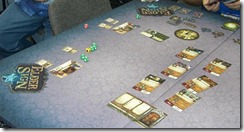 FFG has a game entitled Arkham Horror that is a wonderfully thematic cooperative exploration game set in the Cthulhu mythos, however it can take a long time to set up and longer to play. Elder Sign is Kevin Wilson’s attempt to get the essence of that gameplay down into an accessible, short playing time that takes up much less table space. One to eight players are exploring locations at a museum attempting to complete a set of tasks at each location. As time wears on monsters begin to pop out and bother them to make matters worse. The museum is laid out as a set of cards, including the entrance where players can rest and heal. By moving to a card, a player can then roll dice to attempt to complete a task by rolling the requisite symbols displayed on the location card. Complete the task and earn possible rewards, fail and “bad things happen” – lose health, items, etc… Players can roll the dice a few times, setting some aside, but need to make sure they don’t roll specific unwanted symbols (like the terror symbol) depending on the card. Once the first task is completed on a card, the player can then take the remaining dice and try to roll the second (or later) tasks. Players have items and spells that help with completion, giving extra dice to roll (common dice have mostly good sides, while the unique item dice roll better and have no terror symbols). To complete the game, the players must defeat the ancient one for that game. There are 8 Ancient ones (the same ones found in Arkham Horror), each with a special effect on the game play. Players select from the same 16 Characters in Arkham Horror, each with strengths and weaknesses. With solo play, and gameplay that goes well with up to 6 players (7 and 8 players get a little “tight”), I’m looking forward to looking at this game more closely when it releases later this fall.
FFG has a game entitled Arkham Horror that is a wonderfully thematic cooperative exploration game set in the Cthulhu mythos, however it can take a long time to set up and longer to play. Elder Sign is Kevin Wilson’s attempt to get the essence of that gameplay down into an accessible, short playing time that takes up much less table space. One to eight players are exploring locations at a museum attempting to complete a set of tasks at each location. As time wears on monsters begin to pop out and bother them to make matters worse. The museum is laid out as a set of cards, including the entrance where players can rest and heal. By moving to a card, a player can then roll dice to attempt to complete a task by rolling the requisite symbols displayed on the location card. Complete the task and earn possible rewards, fail and “bad things happen” – lose health, items, etc… Players can roll the dice a few times, setting some aside, but need to make sure they don’t roll specific unwanted symbols (like the terror symbol) depending on the card. Once the first task is completed on a card, the player can then take the remaining dice and try to roll the second (or later) tasks. Players have items and spells that help with completion, giving extra dice to roll (common dice have mostly good sides, while the unique item dice roll better and have no terror symbols). To complete the game, the players must defeat the ancient one for that game. There are 8 Ancient ones (the same ones found in Arkham Horror), each with a special effect on the game play. Players select from the same 16 Characters in Arkham Horror, each with strengths and weaknesses. With solo play, and gameplay that goes well with up to 6 players (7 and 8 players get a little “tight”), I’m looking forward to looking at this game more closely when it releases later this fall.
Wargames
If you still haven’t outgrown little toy soldiers (I know I haven’t) then wargames are a nice, socially acceptable outlet.
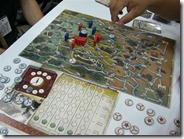 As always, Uwe Eickert of Academy Games was near the Mayfair booth showing off his high production wargames. His newest game on the “block” is Strike of the Eagle, a reworking of The Eagle and the Star – a wargame that uses blocks to preserve a bit of fog of war. Like Stratego, only a block’s owner knows which block is which, and since the blocks are square and can rotate, they also serve as a handy way to keep track of units’ status. Players take turns placing secret orders on unknown (to the opponent) groups of blocks, and once all orders are placed they are executed in sequence. With a mix of hidden orders, hidden unit information, and non-random battle resolution, I think it will be quite a hit.
As always, Uwe Eickert of Academy Games was near the Mayfair booth showing off his high production wargames. His newest game on the “block” is Strike of the Eagle, a reworking of The Eagle and the Star – a wargame that uses blocks to preserve a bit of fog of war. Like Stratego, only a block’s owner knows which block is which, and since the blocks are square and can rotate, they also serve as a handy way to keep track of units’ status. Players take turns placing secret orders on unknown (to the opponent) groups of blocks, and once all orders are placed they are executed in sequence. With a mix of hidden orders, hidden unit information, and non-random battle resolution, I think it will be quite a hit.
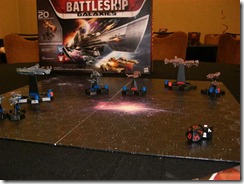 If space is more your niche, Hasbro has just introduced Battleship Galaxies. From the designer of the popular Heroscape combat game, Battleship Galaxies is nearly a wargame, albeit with spiffy plastic miniatures and simplified rules. Hasbro threw a big bash promoting the new Battleship Galaxies on Thursday evening. It included some nice hors d’oeuvres, a raffle, and even designer Craig Van Ness in attendance. I was finally able to look over the game in detail (and even got in a game at my family reunion later) and so far it seems to be a worthy successor to Heroscape. Players are given a budget of 10 energy per turn and use that to activate ships (move and usually fire) and launch new ships. When attacking a ship, two dice are rolled displaying a letter and number (a throwback to Battleship) which are then checked against a spaceship grid diagram. Damage is accessed first against shields (blue pegs) and then start to add hull damage (red pegs). When a ship runs out of hull it is eliminated. However, if you get a ship’s shield down and roll the precise weak-spot number even the largest ship can be destroyed in a single shot. The ship models are very nice, and serve to pull in gamers and non-gamers alike. While the game only has a few dozen models present (including duplicates of fighters) each ship type comes with cards that represent three versions of that ship (normal, seasoned, and veteran) to keep things interesting. (As an aside, the $65 price point might sound a bit high, but I’ve had several people remark on the quality of the space ship pieces – so you are getting your money’s worth.) The game is played via scenarios which include available ships (and their “level”) as well as which event cards each player uses to create an event deck. Event cards may be actual events or they can be ship upgrades, weapons, or pilots that can be played during the game. The game comes with 5 set missions but I’m sure most fans of the game will have no problems starting to design more. I found the game quite scalable, as some things (like event cards) can be easily added or subtracted from the game to make it more playable for younger or less experienced players.
If space is more your niche, Hasbro has just introduced Battleship Galaxies. From the designer of the popular Heroscape combat game, Battleship Galaxies is nearly a wargame, albeit with spiffy plastic miniatures and simplified rules. Hasbro threw a big bash promoting the new Battleship Galaxies on Thursday evening. It included some nice hors d’oeuvres, a raffle, and even designer Craig Van Ness in attendance. I was finally able to look over the game in detail (and even got in a game at my family reunion later) and so far it seems to be a worthy successor to Heroscape. Players are given a budget of 10 energy per turn and use that to activate ships (move and usually fire) and launch new ships. When attacking a ship, two dice are rolled displaying a letter and number (a throwback to Battleship) which are then checked against a spaceship grid diagram. Damage is accessed first against shields (blue pegs) and then start to add hull damage (red pegs). When a ship runs out of hull it is eliminated. However, if you get a ship’s shield down and roll the precise weak-spot number even the largest ship can be destroyed in a single shot. The ship models are very nice, and serve to pull in gamers and non-gamers alike. While the game only has a few dozen models present (including duplicates of fighters) each ship type comes with cards that represent three versions of that ship (normal, seasoned, and veteran) to keep things interesting. (As an aside, the $65 price point might sound a bit high, but I’ve had several people remark on the quality of the space ship pieces – so you are getting your money’s worth.) The game is played via scenarios which include available ships (and their “level”) as well as which event cards each player uses to create an event deck. Event cards may be actual events or they can be ship upgrades, weapons, or pilots that can be played during the game. The game comes with 5 set missions but I’m sure most fans of the game will have no problems starting to design more. I found the game quite scalable, as some things (like event cards) can be easily added or subtracted from the game to make it more playable for younger or less experienced players.
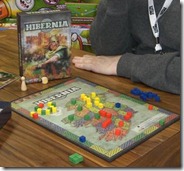 One final wargame I came across was Hibernia, being reprinted by Sandstorm Productions. The designer, Eric B. Vogel liked to consider the game the minimal essence of a wargame. Up to four players war over a four color game board, placing pieces on adjacent territories. On one’s turn, a die is rolled and players may put down cubes into an adjacent area matching the color of the die. They must place the same number of cubes as adjacent territories they have adjacent. (Thus, you must place two cubes if you own two adjacent territories.) Players also have a “free” color each turn where they can “attack” an adjacent territory of any color. Cubes placed in enemy areas are eliminated on a one to one basis and placed in a “dead” pool. Any player may forgo one of their actions on a turn to claim all their dead cubes back, but all the other players will then receive half of their dead cubes back. Perhaps the most unique aspect of the game is the scoring track. Rather than track total areas controlled, players attempt to move around the outer score track by holding the requisite colored countries. In most cases, owning one of each of the four colors on a turn will provide a player with a four space advancement. However, the scoring track occasionally has duplicate colors (two blues in a row, etc…) forcing players to attack and hold multiple copies of a single color in a turn – not easy since colors are rarely near each other and player cubes are fairly limited. To add in a touch of luck to the game, the die rolled may sometimes come up black (granting a second “player choice” color to attack) or purple. Purple dice don’t grant an attack, but are worth the equivalent of any missing color country when it is time for a player to score on the scoring track. Another small box game with a quick playing time, the new version of Hibernia should be out at the end of September.
One final wargame I came across was Hibernia, being reprinted by Sandstorm Productions. The designer, Eric B. Vogel liked to consider the game the minimal essence of a wargame. Up to four players war over a four color game board, placing pieces on adjacent territories. On one’s turn, a die is rolled and players may put down cubes into an adjacent area matching the color of the die. They must place the same number of cubes as adjacent territories they have adjacent. (Thus, you must place two cubes if you own two adjacent territories.) Players also have a “free” color each turn where they can “attack” an adjacent territory of any color. Cubes placed in enemy areas are eliminated on a one to one basis and placed in a “dead” pool. Any player may forgo one of their actions on a turn to claim all their dead cubes back, but all the other players will then receive half of their dead cubes back. Perhaps the most unique aspect of the game is the scoring track. Rather than track total areas controlled, players attempt to move around the outer score track by holding the requisite colored countries. In most cases, owning one of each of the four colors on a turn will provide a player with a four space advancement. However, the scoring track occasionally has duplicate colors (two blues in a row, etc…) forcing players to attack and hold multiple copies of a single color in a turn – not easy since colors are rarely near each other and player cubes are fairly limited. To add in a touch of luck to the game, the die rolled may sometimes come up black (granting a second “player choice” color to attack) or purple. Purple dice don’t grant an attack, but are worth the equivalent of any missing color country when it is time for a player to score on the scoring track. Another small box game with a quick playing time, the new version of Hibernia should be out at the end of September.
Family and Party Games
GenCon continues to be more and more family friendly, and the retailers are there to support more casual gamers as well. (Or supply gamers with games to share with their less-gamer-y friends…)
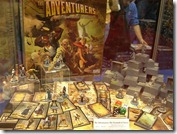 If you saw The Adventurers from AEG a couple years back, you’ll be familiar with this next game in the series from FFG. Players delve into the Pyramid of Horus to find the “loot” and make it back out without being crushed by the (very cool looking) giant stone blocks. As a family game, it should go over well with that crowd having a nice push your luck component, plenty of plastic to ooh and aah over, and fairly straightforward rules.
If you saw The Adventurers from AEG a couple years back, you’ll be familiar with this next game in the series from FFG. Players delve into the Pyramid of Horus to find the “loot” and make it back out without being crushed by the (very cool looking) giant stone blocks. As a family game, it should go over well with that crowd having a nice push your luck component, plenty of plastic to ooh and aah over, and fairly straightforward rules.
LEGO Champion is a new game that takes some of that Creationary game play and makes a LEGO party game targeted right at families. 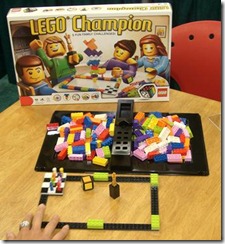 Players take turns at various competitions involving basic LEGO bricks such as Code Breaker, LEGO Stacking (players take turns stacking by adding a LEGO configuration consisting of one more brick than the previous piece added to the tower), speed building, brick throwing, and even a sort of bluffing game that sounds just a bit like Liar’s Dice. I didn’t go over the rules in detail but with LEGO’s popularity and what seems to be a strong party game basis this could be at least as much of a hit as Creationary, last year’s cross between Pictionary and LEGOs.
Players take turns at various competitions involving basic LEGO bricks such as Code Breaker, LEGO Stacking (players take turns stacking by adding a LEGO configuration consisting of one more brick than the previous piece added to the tower), speed building, brick throwing, and even a sort of bluffing game that sounds just a bit like Liar’s Dice. I didn’t go over the rules in detail but with LEGO’s popularity and what seems to be a strong party game basis this could be at least as much of a hit as Creationary, last year’s cross between Pictionary and LEGOs.
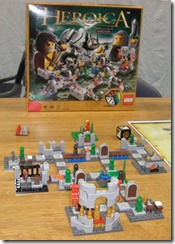 LEGO Heroica was on hand, of course. If you aren’t familiar with it, Heroica is a line of four LEGO boardgames based loosely on dungeon exploration. Players take turns walking around a building/dungeon/fortress, gather weapons, try to defeat monsters, and hope to get the most treasure. Not really enough of a game to make adult boardgamers happy, this is more for the younger set, but seems to be hitting it off well with that target audience. It released this past summer so should be available in most toy stores.
LEGO Heroica was on hand, of course. If you aren’t familiar with it, Heroica is a line of four LEGO boardgames based loosely on dungeon exploration. Players take turns walking around a building/dungeon/fortress, gather weapons, try to defeat monsters, and hope to get the most treasure. Not really enough of a game to make adult boardgamers happy, this is more for the younger set, but seems to be hitting it off well with that target audience. It released this past summer so should be available in most toy stores.
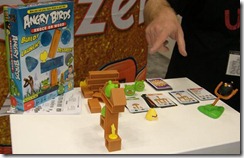 Mattel was back with their booth full of card games and other dexterity games that are family-friendly. This year two new games stood out, Angry Birds and Mind Flex Duel.
Mattel was back with their booth full of card games and other dexterity games that are family-friendly. This year two new games stood out, Angry Birds and Mind Flex Duel.
Angry Birds is exactly what you think a boardgame would be about the popular iPhone game. Set up some pigs on a bunch of plastic wooden beams and then launch little bird figures at them 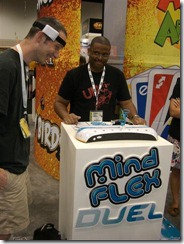 using an included slingshot. Not a lot of strategy here, but plenty of fun with cute little plastic pieces to be had.
using an included slingshot. Not a lot of strategy here, but plenty of fun with cute little plastic pieces to be had.
Playing games with only your mind is back, and now you can include a fair bit of smack talk as two people can hook their minds into this game (you wear a little headband with metal disks that touch your skin). The game does actually measure brainwaves so players have to “think” hard to cause the game to rev its little fan, lifting a little ball into the air. The game can be played solo, cooperatively, or against another opponent. I didn’t get the price point, but expect it to be up there with a pretty high end boardgame.
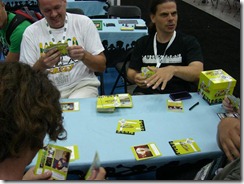 The final game to mention is a strange one, Crappy Birthday. The guys at North Star Games were showing off the new Crappy Birthday in their booth. I was really underwhelmed with the game until I saw it played. Players pass cards with bad gifts to one player who then selects which gift they want the least. This seems like a fairly boring rip-off of Apples to Apples until I got a glance at the cards. The cards are huge square things with excellent photos of some really crappy gifts. What is going to make this game are the crazy gifts people can give one another. I’m now in the camp that think this game is quite fun. However, I will keep a slight reservation that I suspect it to be one of those games that will wear thin if played too much. Most of the humor and fun are in the cards and once they’re all known and familiar the game may lose quite a bit of its luster. Even so, I think it’s a great party game for quite a number of plays.
The final game to mention is a strange one, Crappy Birthday. The guys at North Star Games were showing off the new Crappy Birthday in their booth. I was really underwhelmed with the game until I saw it played. Players pass cards with bad gifts to one player who then selects which gift they want the least. This seems like a fairly boring rip-off of Apples to Apples until I got a glance at the cards. The cards are huge square things with excellent photos of some really crappy gifts. What is going to make this game are the crazy gifts people can give one another. I’m now in the camp that think this game is quite fun. However, I will keep a slight reservation that I suspect it to be one of those games that will wear thin if played too much. Most of the humor and fun are in the cards and once they’re all known and familiar the game may lose quite a bit of its luster. Even so, I think it’s a great party game for quite a number of plays.
Other Boardgames of Note:
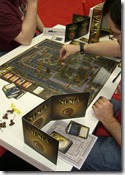 In addition to their card games, AEG was showing off Ninja. Ninja is a new two player board game where players control either the guards or the ninja attempting to steal an item. The guards begin the game positioned around the board and they remain fixed, unless they manage to “hear” the ninja pass close by. The ninja scouts throughout the palace trying to find a hidden item. The faster they move, the more they can explore, but faster movement also makes more noise and allows the guards to react. The Ninja starts with a fixed hand of cards, while the Guard player draws more cards as time wears on. The Ninja wins if they escape with the item, while the Guard is simply trying to find the Ninja and catch them. Looks to be a nice two player take on a sort of Scotland Yard style of play where one player is moving in secret while the other(s) are trying to surround and reveal them.
In addition to their card games, AEG was showing off Ninja. Ninja is a new two player board game where players control either the guards or the ninja attempting to steal an item. The guards begin the game positioned around the board and they remain fixed, unless they manage to “hear” the ninja pass close by. The ninja scouts throughout the palace trying to find a hidden item. The faster they move, the more they can explore, but faster movement also makes more noise and allows the guards to react. The Ninja starts with a fixed hand of cards, while the Guard player draws more cards as time wears on. The Ninja wins if they escape with the item, while the Guard is simply trying to find the Ninja and catch them. Looks to be a nice two player take on a sort of Scotland Yard style of play where one player is moving in secret while the other(s) are trying to surround and reveal them.
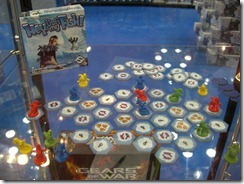 FFG is rereleasing Hey, That’s My Fish in a new “non-deluxe” version and they had it on display. It is a lightweight game where players place and move their penguins on hexagonal fish tiles, removing the tiles after they move. The strategy is to manage to not walk your penguins into a corner. The new edition looked like a nice little setup and could even be considered a pocket game (if you have big pockets). At a $12 price point, it should be well positioned for family gaming when the holiday season arrives.
FFG is rereleasing Hey, That’s My Fish in a new “non-deluxe” version and they had it on display. It is a lightweight game where players place and move their penguins on hexagonal fish tiles, removing the tiles after they move. The strategy is to manage to not walk your penguins into a corner. The new edition looked like a nice little setup and could even be considered a pocket game (if you have big pockets). At a $12 price point, it should be well positioned for family gaming when the holiday season arrives.
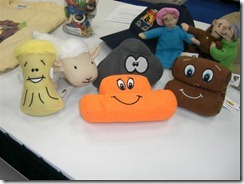 Mayfair was hopping once again with a booth full of demos and the demo-playing public, however these little guys caught my eye. Yes, the next Settlers expansion is actually a bunch of stuffed resources. (And you thought Beanie Babies were bad.) They are more than just stuffed animals, as they’re supposed to add to your game. Players keep track of settlements and cities on each land type. When a player has placed their settlement adjacent to three production centers (cities count double) they can grab the appropriate plushie doll. Thus, if you have a city and a settlement around the same forest, you could grab the wooden plushie. The dolls are worth 1 VP and are kept next to you since, like the longest road, they can be snatched away if you fall behind in the resource wars. With the extra VP present, Settlers games should increase in length by a couple more VPs.
Mayfair was hopping once again with a booth full of demos and the demo-playing public, however these little guys caught my eye. Yes, the next Settlers expansion is actually a bunch of stuffed resources. (And you thought Beanie Babies were bad.) They are more than just stuffed animals, as they’re supposed to add to your game. Players keep track of settlements and cities on each land type. When a player has placed their settlement adjacent to three production centers (cities count double) they can grab the appropriate plushie doll. Thus, if you have a city and a settlement around the same forest, you could grab the wooden plushie. The dolls are worth 1 VP and are kept next to you since, like the longest road, they can be snatched away if you fall behind in the resource wars. With the extra VP present, Settlers games should increase in length by a couple more VPs.
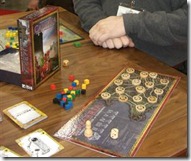 The other strategy game demoed by Sandstorm Productions was Cambria. Due out in September, Cambria is a little area majority game where 3 to 5 players roll two dice and choose one for their move. The game board has a map of cities labeled two to six with the same number of roads leading off of them. Players choose one die and place a cube next to a city of the same number. When a city is fully surrounded, it is scored and a numbered token (worth the city’s number) is rewarded to the player who has the most cubes surrounding it. For 5 and 6 point cities, there are also second place tokens worth 3 and 4 points respectively. Finally, if a “1” is rolled, a player can kick out a single cube and also “store” a roll for future use (if you don’t like either of your dice on a future turn.) Since players only have a few cubes, it is important to make the best use of them possible. If you run out, you can start moving them around (if, for example, they’re on a route between two already claimed cities) but they are definitely limited. The game plays in about 20 minutes, and even has a double-sided game board to add some variety. With a small box footprint (and one of those extremely sturdy boxes), Cambria would also make a fairly decent portable game.
The other strategy game demoed by Sandstorm Productions was Cambria. Due out in September, Cambria is a little area majority game where 3 to 5 players roll two dice and choose one for their move. The game board has a map of cities labeled two to six with the same number of roads leading off of them. Players choose one die and place a cube next to a city of the same number. When a city is fully surrounded, it is scored and a numbered token (worth the city’s number) is rewarded to the player who has the most cubes surrounding it. For 5 and 6 point cities, there are also second place tokens worth 3 and 4 points respectively. Finally, if a “1” is rolled, a player can kick out a single cube and also “store” a roll for future use (if you don’t like either of your dice on a future turn.) Since players only have a few cubes, it is important to make the best use of them possible. If you run out, you can start moving them around (if, for example, they’re on a route between two already claimed cities) but they are definitely limited. The game plays in about 20 minutes, and even has a double-sided game board to add some variety. With a small box footprint (and one of those extremely sturdy boxes), Cambria would also make a fairly decent portable game.
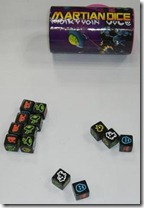 A small bonus to me at the Tasty Minstrel booth, I was introduced to Martian Dice. Players take on the role of aliens trying to abduct Earth’s leaders, but we’re not sure who the leaders are. The goal is to collect humans, chickens, and cows without running afoul of the army. The game is a set of dice with symbols for humans, chickens, cows, tanks (army), and UFO lasers. Play the game like Yahtzee or To Court the King, setting aside a set of one type of dice for each roll. Tanks must always be set aside, and each of the abductees can only be set aside once (UFO Lasers can be set aside multiple times in a game). At the end of the rolling, a player must have more Lasers than Tanks showing, and can then score their abductees. One point for each abducted die, plus a bonus 3 points if you have one of each type (for further analysis by your scientists presumably.) It’s a quick moving game, the dice are nifty black ones with colored symbols and it comes in a handy little travel-easy cylinder. It went over well with the teens at my family reunion, although my can didn’t contain any rules (or they were lost right away somehow?) The basic rules are on the outside cardboard of the package, which I hadn’t taken along (thankfully they’re also up on the BGG.) As far as dice-based travel games this isn’t a deep game but meets the criteria of easy to play, attractive pieces, and a smidge of push your luck gameplay to make it worth considering.
A small bonus to me at the Tasty Minstrel booth, I was introduced to Martian Dice. Players take on the role of aliens trying to abduct Earth’s leaders, but we’re not sure who the leaders are. The goal is to collect humans, chickens, and cows without running afoul of the army. The game is a set of dice with symbols for humans, chickens, cows, tanks (army), and UFO lasers. Play the game like Yahtzee or To Court the King, setting aside a set of one type of dice for each roll. Tanks must always be set aside, and each of the abductees can only be set aside once (UFO Lasers can be set aside multiple times in a game). At the end of the rolling, a player must have more Lasers than Tanks showing, and can then score their abductees. One point for each abducted die, plus a bonus 3 points if you have one of each type (for further analysis by your scientists presumably.) It’s a quick moving game, the dice are nifty black ones with colored symbols and it comes in a handy little travel-easy cylinder. It went over well with the teens at my family reunion, although my can didn’t contain any rules (or they were lost right away somehow?) The basic rules are on the outside cardboard of the package, which I hadn’t taken along (thankfully they’re also up on the BGG.) As far as dice-based travel games this isn’t a deep game but meets the criteria of easy to play, attractive pieces, and a smidge of push your luck gameplay to make it worth considering.
With that long-winded account of my “day of GenCon 2011”, I’ll leave you to discuss amongst yourselves in the comments. With the holiday shopping season coming up on us quickly, I’ll do my best to report back on some of these games once I’ve had a chance to give them a good run-through.

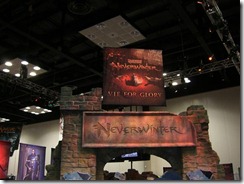




Discussion Area - Leave a Comment